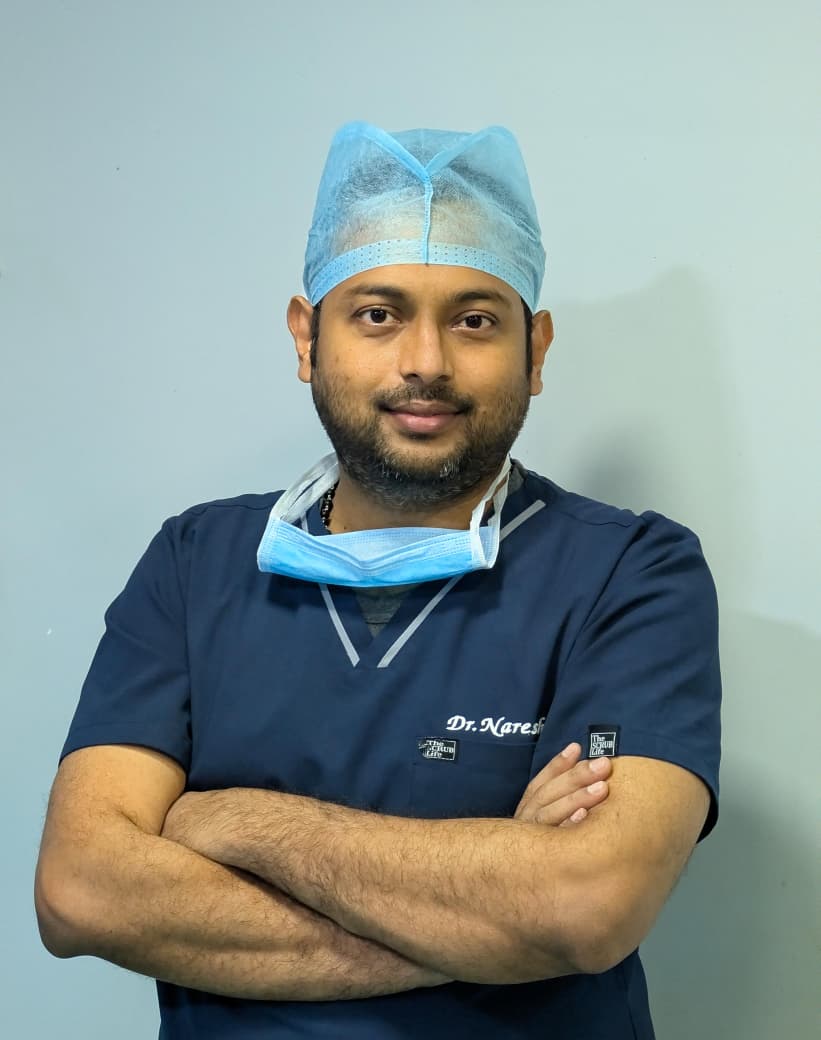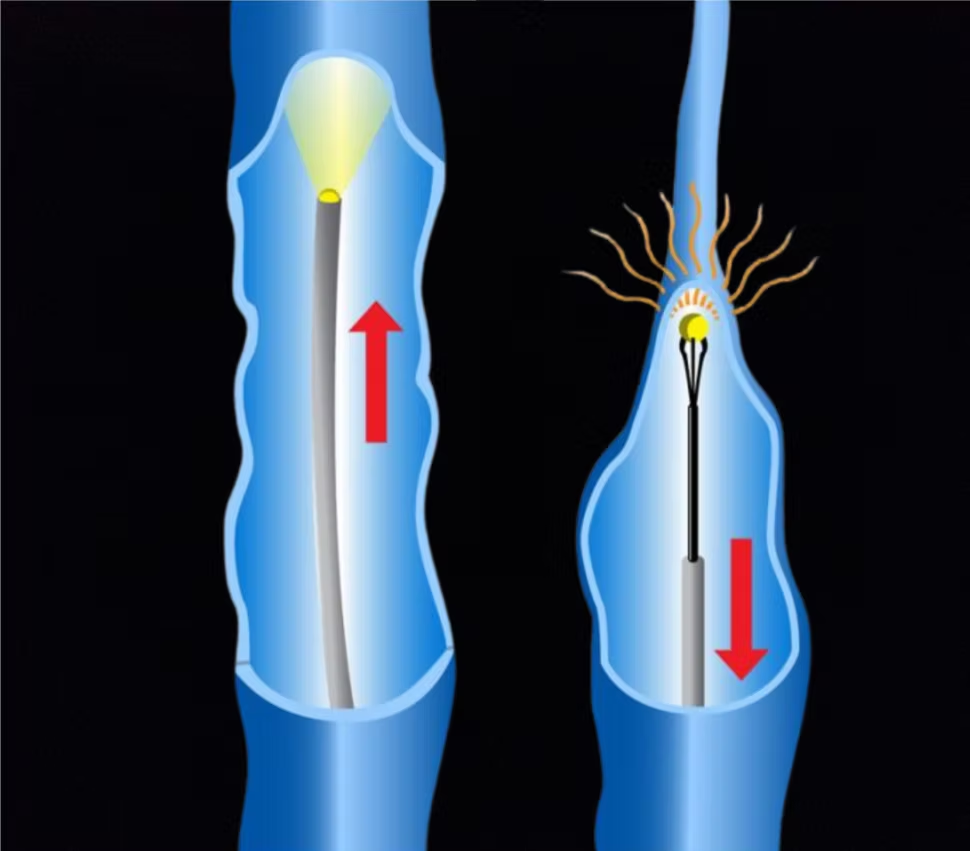Don’t ignore the pain and swelling in the legs. It can be severe and a sign of deep vein thrombosis. Get advanced treatment for Deep vein thrombosis (DVT) for an effective solution and relief from the painful symptoms. Contact HeptaCare Health to consult the best vascular doctors in India and determine the most suitable treatment for DVT. Book a consultation today.
Happy Patients
Disease
Hospitals
Cities
Deep Vein Thrombosis or DVT is a condition where blood clots form in the deep veins, most commonly in the legs and pelvis region. This condition usually develops due to a combination of factors, including decreased blood flow, increased tendency to clot, and inflammation in the blood vessels. The blood clot thus formed can partially or completely disrupt the blood flow through the vein and result in extreme pain, swelling, and discoloration in the affected areas.
Normally, deep vein thrombosis is not a life-threatening condition, but if left untreated, it can lead to serious complications, such as Pulmonary embolism (PE), post-thrombotic syndrome, etc., which can be fatal. Thus, treatment is crucial for DVT. Before suggesting the most suitable treatment method, the doctor diagnoses the condition thoroughly to identify its severity and then creates a customized treatment plan. To learn more about the condition and its treatment, it’ll be best to get in touch with HeptaCare Health

Medical History & Physical Evaluation
The doctor will start by taking a detailed medical history of the patient, including previous surgeries, lifestyle, family history of clotting disorders, and current medications. The doctor will also conduct a physical examination to check for signs of DVT, such as swelling, pain, warmth, and redness in the affected leg.
Imaging Tests
Various tests are recommended by the doctor to rule out DVT or to determine the safest method of treatment. Common tests performed include the following:
Based on the above deep vein thrombosis tests, if the doctor believes that the patient may have a genetic or acquired clotting disorder, he/she may suggest further evaluations.
If the patient is at high risk of developing deep vein thrombosis, some additional evaluations may also be done, including:
Based on the information gathered through the diagnostic tests and evaluations, the doctor will enlist the findings and discuss the treatment options with the patients.
The management or treatment option for DVT is determined based on the severity of the conditions. The following options for DVT treatment are available for the patients:
In the early stages, the doctor is likely to recommend lifestyle changes, such as elevating legs, exercising, eating healthy, etc., but as the condition progresses, anticoagulation medications or thrombolysis becomes a more effective method for DVT treatment. If the medications alone cease to work, then the doctor may recommend surgical removal of the clot or placing a filter in the deep vein (vena cava) to prevent life-threatening complications of DVT. Compression stockings for DVT are advised to be used consistently regardless of the treatment method to manage the symptoms.
Deep vein thrombosis surgery or DVT surgery refers to the procedures performed to treat DVT. Surgical interventions are considered necessary when DVT is severe, causing significant symptoms, and non-surgical options have failed to resolve the condition. Some common surgical treatment options for DVT include the following:
It should be noted that the decision to undergo DVT surgery is made after careful consideration of the patient’s overall health, the location and severity of the clot, and potential risks. The most suitable method for DVT treatment is determined by the vascular surgeon.
DVT Treatment is primarily aimed at preventing its complications, improving the symptoms, and reducing the risk of recurrence. Whether the patient gets surgical or non-surgical treatment, the advantages include the following:
DVT treatment plans are tailored to the individual patient’s condition, taking into account factors such as age, medical history, overall health, and risk factors. This personalized approach ensures that the treatment is appropriate and effective for the patient’s unique situation.
Once the surgery is scheduled, the doctor will provide detailed instructions to the patients to prepare them for the procedure. The patient will receive some instructions that need to be followed strictly to ensure the surgery’s success. Though the specific instructions will vary from one patient to another, some general instructions are given below:
Before Surgery:
On the Day of Surgery:
Adhere to the preoperative guidelines given by the doctor and his/her team. After arrival at the hospital, the nurses ask the patient to change into a clean hospital gown, and an IV line is inserted into their arm to administer medications. The anesthetist will also discuss the anesthesia options with the patient. Once the patient is prepped for the surgery, the nurses will take him/her to the operating room.
*Note: The patients are advised to read the consent form thoroughly before signing it and don’t hesitate to ask questions prior to the surgery.
Depending on the technique being used, the steps of DVT treatment will vary. The general step-by-step procedure will involve the following:
The entire procedure can take around 1 to 2 hours, depending on the technique being used.
There are certain non-invasive treatment options for treating the condition of deep vein thrombosis by preventing the blood clot from getting bigger or breaking loose and traveling to the lungs. Depending upon the severity of your condition, the doctor might prescribe a number of medications or preventive gear that include:
Immediately after DVT surgery, the patient is taken to the recovery area, where he/she will be closely monitored until the effects of anesthesia wear off. The vital signs of the patients, including heart rate, blood pressure, oxygen levels, etc., are monitored.
The patient can expect to feel slightly disoriented, nauseous, and confused after waking up, but these side effects will improve in the next few hours. There will be mild to moderate pain in the incision site, which will be managed through pain medications. The leg may also be swollen and bruised, which can limit the patient’s mobility.
Depending on the surgery performed, the patient may be discharged on the same day or require hospitalization. Before discharge, the patient is given detailed post-op care instructions, a diet plan, an activity guide, and a follow-up schedule to monitor the recovery.
The recovery timeline for DVT Treatment can vary depending on factors such as the severity of the DVT, the chosen treatment approach, and individual patient factors. Overall, patients may need 4 to 5 weeks to recover after DVT treatment. The general DVT surgery recovery time will be as below:
For the long term, the doctor may advise the patient to make certain lifestyle adjustments and continue using blood thinners and compression stockings for DVT. Even after the recovery is complete, the patient needs to regularly monitor his/her health, look out for the signs of DVT, and get regular check-ups.
During the recovery period after DVT surgery, the patient will need to follow several instructions for optimal and smooth recovery. The common tips are given below:
The specific risks and complications associated with DVT can vary depending on factors such as the type of surgery, the patient’s overall health, and any underlying medical conditions. Some potential complications of DVT surgery include the following:
In most cases, the surgeon identifies these risks beforehand and takes the necessary measures to prevent them from arising in the first place. The patients are also advised to follow the surgeon’s instructions strictly to manage the potential complications after surgery.
Preventing the recurrence of Deep Vein Thrombosis (DVT) involves making certain lifestyle changes to reduce the risk of blood clot formation. It’s important to work closely with the doctor to develop a comprehensive plan tailored to the individual needs and medical history. Here are some lifestyle changes that might be recommended to help prevent DVT recurrence-
While some of the DVT risk factors can be managed and controlled by patients, there are still numerous factors that are out of control. Thus, following these guidelines alone may or may not be sufficient to prevent DVT recurrence. It’ll be best to talk to the doctor to take the necessary steps and reduce the chances of blood clot formation as much as possible.

DVT surgery cost in India ranges from Rs. <minCost> to Rs. <maxCost>
or more. This is only an estimated price range, and the actual cost may vary depending on factors such as the type of surgery, the hospital or medical facility, the location or city, the surgeon’s expertise, hospital-related expenses, prescribed medications, pre-and post-surgery care, and several other factors.
The cost of surgery usually includes fees for the surgical team, hospital stay, anesthesia, medications, preoperative and postoperative care, and other related services. Additional costs might include diagnostic tests, follow-up appointments, and any complications that arise during or after surgery. To get an estimate, call HeptaCare Health and talk to our experts.
Yes, DVT is a critical condition that can lead to life-threatening complications if not treated on time. Thus, its treatment is deemed a medical necessity and covered by all health insurance plans under all circumstances. The patient only needs to file a claim request with the TPA at the hospital or clinic where he/she is getting treatment and obtain a pre-authorization. Once the insurance company approves the claim, the patient can get DVT treatment as required without worrying about the cost.
The insurance policy will cover the expense of doctor’s consultation, surgery cost, medications, diagnostic tests, hospital stay, follow-ups, anesthetist fee, operating room charges, medical consumables, and second opinions. However, there may be certain clauses, such as deductibles or copays, that may require the patient to cover certain expenses incurred during the treatment. To clearly understand the inclusions and exclusions of the insurance policy, it’ll be best to talk to the insurance providers.
There are several alternatives to surgical treatment for DVT, which can be used as standalone methods or in combination with surgery for effective results. The common non-surgical alternatives for DVT treatment include the following.
While DVT treatment at home is not entirely possible, home remedies can provide temporary relief from the symptoms and may improve the overall health of the patients. Some common home remedies worth trying are:
While these natural ingredients readily available at home can be helpful in improving blood flow and dissolving the existing blood clots due to their blood thinning properties, patients should not rely on them entirely. Furthermore, DVT patients should always consult their doctor about using these home remedies with oral anticoagulant medications as they can lead to excessive blood thinning.
Anticoagulant medications are the first line of treatment for deep vein thrombosis to prevent and dissolve blood clots. Typically, warfarin and heparin are the most commonly used DVT anticoagulation medications. In extreme cases (higher risk of pulmonary embolism), thrombolytics or thrombolysis is recommended for the patient.
In the initial stages, injectable heparin, also called unfractionated heparin, is given to the patient intravenously for thromboprophylaxis. This anticoagulant is preferred when the clot needs to be dissolved as soon as possible. Unlike this, warfarin is an oral anticoagulant that takes around 48 to 72 hours to take effect. Some commonly used deep vein thrombosis anticoagulation medications are listed below:
The patient should not take any anticoagulant medications without consulting the doctor or make changes (increase, decrease, start, or stop) to the dosages. In most cases, patients may also be advised to make certain lifestyle changes to prevent further problems.
Patients who are at high risk of DVT or have had DVT surgery may be prescribed to wear compression stockings to promote blood circulation and prevent the pooling of blood that increases the risk of blood clot formation.
DVT stockings are special, tight-fitting stockings that gently compress the leg. The deep vein thrombosis compression stockings are usually tight at the ankle and comparatively loose at the calves. They need to be used for as long as possible and as much as possible.
As DVT stockings are available in different lengths and sizes, it’ll be best to consult a specialist to determine which would be a more suitable and safe option. Compression stockings also come with different levels of pressure (measured in mmHg). To manage DVT, patients will likely need somewhat tighter stockings.


Based on 7721 Recommendations | Rated 4.68 Out of 5
Happy Patients
Clinics
Cities
Surgeries
Doctors
Hospitals

Get relief from painful proctology with advanced laser treatment.
Minimally invasive, no stitches, same-day discharge…

Varicose veins are swollen, twisted veins that usually appear on the legs due to poor blood flow or weakened vein valves.

Treat anal fistula with safe, advanced procedures.
Minimally invasive care with faster recovery.

Treatments include lifestyle changes, compression stockings, laser therapy, sclerotherapy, and minimally invasive surgeries like laser or radiofrequency ablation.
With advanced laser or radiofrequency treatments, recurrence is very low, but maintaining a healthy lifestyle helps prevent new varicose veins from forming.
If you have severe pain, swelling, skin changes, bleeding veins, or ulcers, your doctor may recommend surgical or laser treatment for long-term relief.
Yes, laser treatment is a safe, minimally invasive procedure with quick recovery, less pain, and lower chances of recurrence compared to traditional surgery.
varicose veins laser surgery cost in Vizag ● low-cost varicose veins surgery in Hyderabad ● cashless varicose veins treatment near me ● painless varicose veins surgery in Vijayawada ● varicose veins treatment with insurance in Vizag ● varicose veins removal surgery cost in Hyderabad ● varicose veins operation packages in Vijayawada ● affordable varicose veins treatment near me ● varicose veins laser treatment clinic in Hyderabad ● varicose veins doctor consultation charges in Vizag ● best varicose veins surgery cost in Vijayawada ● varicose veins treatment hospital near me ● varicose veins laser operation price in Hyderabad ● low-cost varicose veins laser treatment in Vizag ● varicose veins removal cost near me ● varicose veins treatment with EMI in Vijayawada ● varicose veins surgery specialist near me ● varicose veins surgery packages in Hyderabad ● varicose veins treatment clinic near me ● varicose veins laser surgery near me
Disclaimer: **The result and experience may vary from patient to patient.. ***By submitting the form or calling, you agree to receive important updates and marketing communications.
Getting an accurate diagnosis can be one of the most impactful experiences that you can have.

cure with care
Copyright © 2025. All rights reserved.
Consult with our expert surgeon for more than 50+ diseases
Happy Patients
Hospitals
Cities